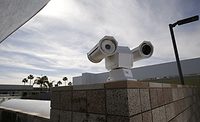
Selecting an access control system for a commercial building is one of the important decisions a commercial owner or manager can make. These systems are critical both in protecting commercial buildings and its tenants as well as maintaining smooth day-to-day operations.
In recent years, major digital and biometric advances have evolved to combat ever-changing threats, which can make navigating the security landscape more difficult. It is important to understand that the best security system for a property does not always equate to the most advanced system. Careful assessment of security needs and goals will help security managers select a system to best match the building’s needs and lay the foundation for a secure building.
Anything that could harm the critical operations and assets of a business is considered a security threat. Common threats include intruders, disgruntled employees, terrorists and natural disasters. To help select an access controls system, security executives must consider certain factors.
DO THE RESEARCH
Find out your building’s background. Buildings located near transportation centers, tourist attractions and cultural centers are inherently at a higher risk of security breaches. It is important to research any history of threats to the building and surrounding area, which can be done by contacting the local police department. Landmarked properties are often located in historic, high-risk areas and require higher-level systems.
Consider whether tenant companies are high-risk. While all businesses have unique security concerns, certain tenants require additional security precautions that must be taken into consideration when selecting an access controls system for the entire building. Tenants such as chemical companies, government offices and banks are high-risk and in turn require a higher level of security.
Learn tenants’ security goals, risks and plans. For most tenants, the chief concern will likely be guarding physical safety and maintaining the integrity of information systems. Go one step further to ask employees’ opinion toward security. Do employees feel safe at work? What type of security systems do tenants feel comfortable using? Getting tenants on board with an access control system will make the execution of security measures far more effective.
After assessing individual tenants, evaluate the collective tenant base. A retail tenant or health care provider with walk-in visitors will greatly increase the amount of traffic in the building. Develop a program for handling visitors and follow a consistent protocol at all times. Lobby congestion can be an issue with higher-level systems, which can sometimes take more time to get people through.
New security developments include biometric systems, security video and smart cards, with biometrics generally being the most expensive and smart cards the least expensive. Building owners should find a system that is both effective and affordable. One solution: Have your tenants hire personnel to administer security systems for their individual offices. This way, the entire building system is both better integrated and more affordable.
Life of the System
Consider the useful life of the system and any future building needs. Security technology will continue to advance, coming up with both better and more cost-effective methods. Security systems should be reviewed every three to five years to ensure systems are up to date and compliant.
The security industry is making enormous advances as it progresses toward technological independence, but we have found that there is also no true substitute for the watchful eye of a highly trained security officer. A combination state-of-the-art digital access and physical security officer system will create multiple layers of security precautions. Building owners and security executives can be confident they have provided the building and their tenants with a safe and secure place to work.






